
How to Use Solar charge controller: Examples, Pinouts, and Specs
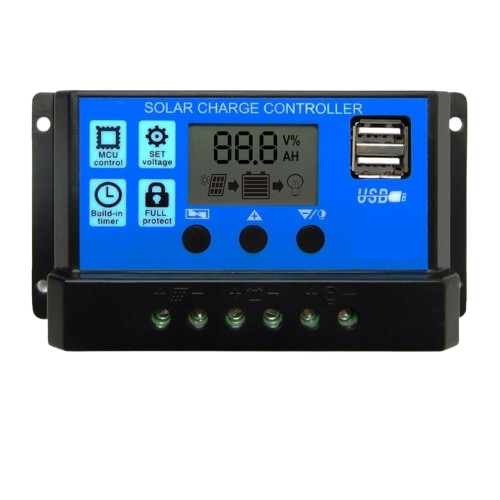
 Design with Solar charge controller in Cirkit Designer
Design with Solar charge controller in Cirkit DesignerIntroduction
A solar charge controller is an essential device in solar power systems. It regulates the voltage and current coming from a solar panel to a battery, ensuring optimal charging and preventing overcharging. By managing the energy flow, it protects the battery from damage and extends its lifespan. Solar charge controllers are commonly used in off-grid solar systems, RVs, boats, and remote power setups.
Explore Projects Built with Solar charge controller
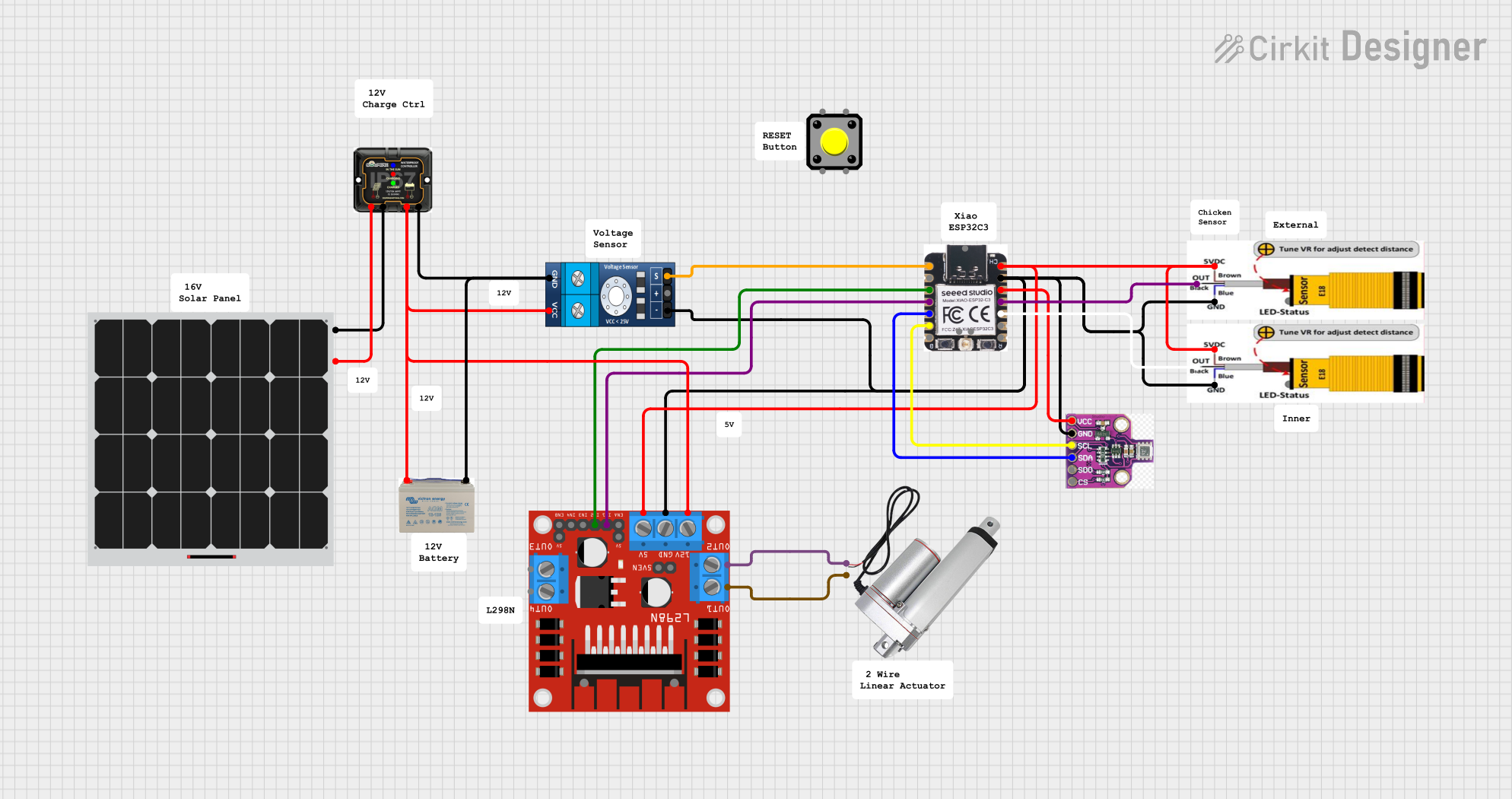
 Open Project in Cirkit Designer
Open Project in Cirkit Designer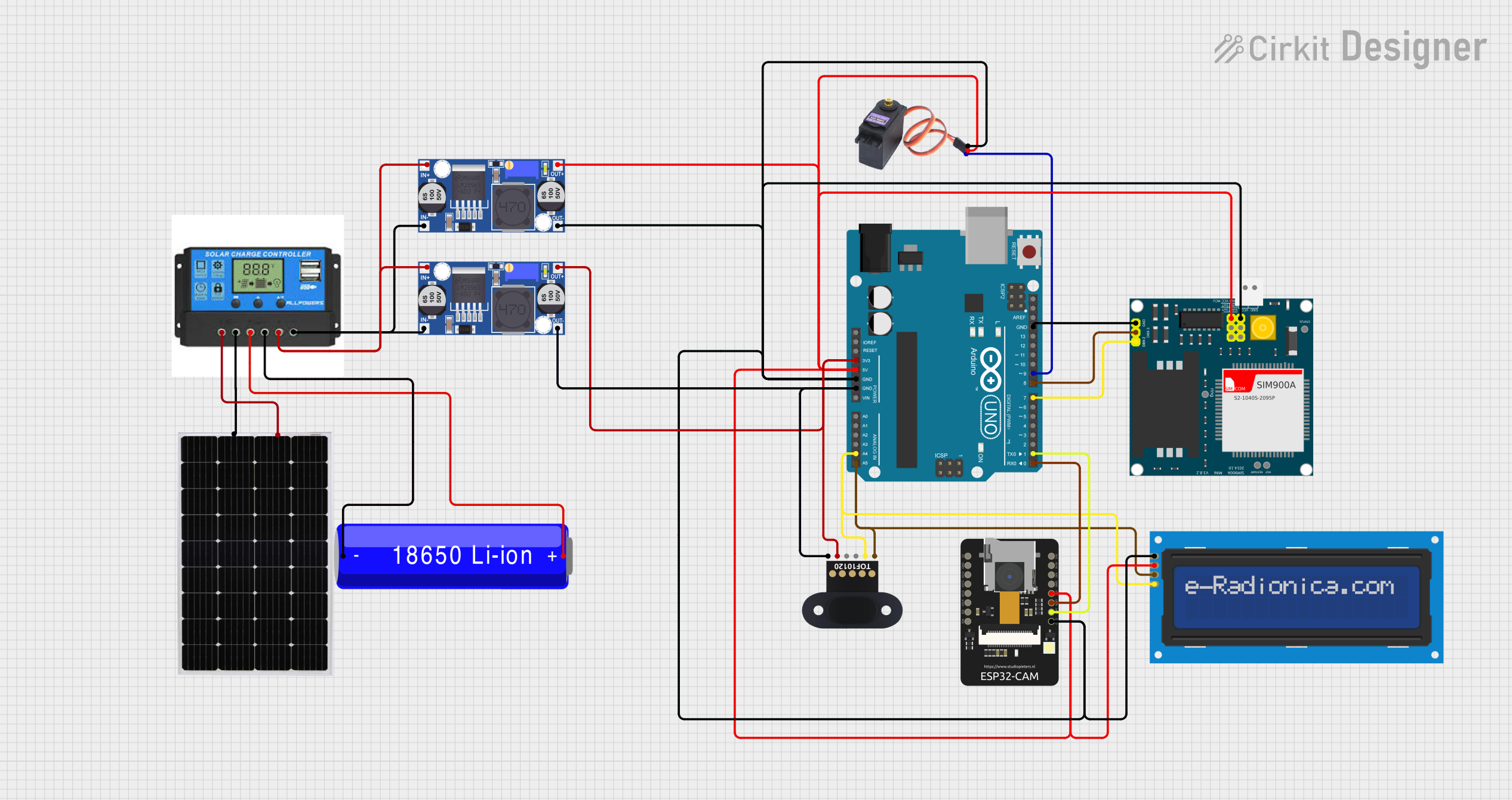
 Open Project in Cirkit Designer
Open Project in Cirkit Designer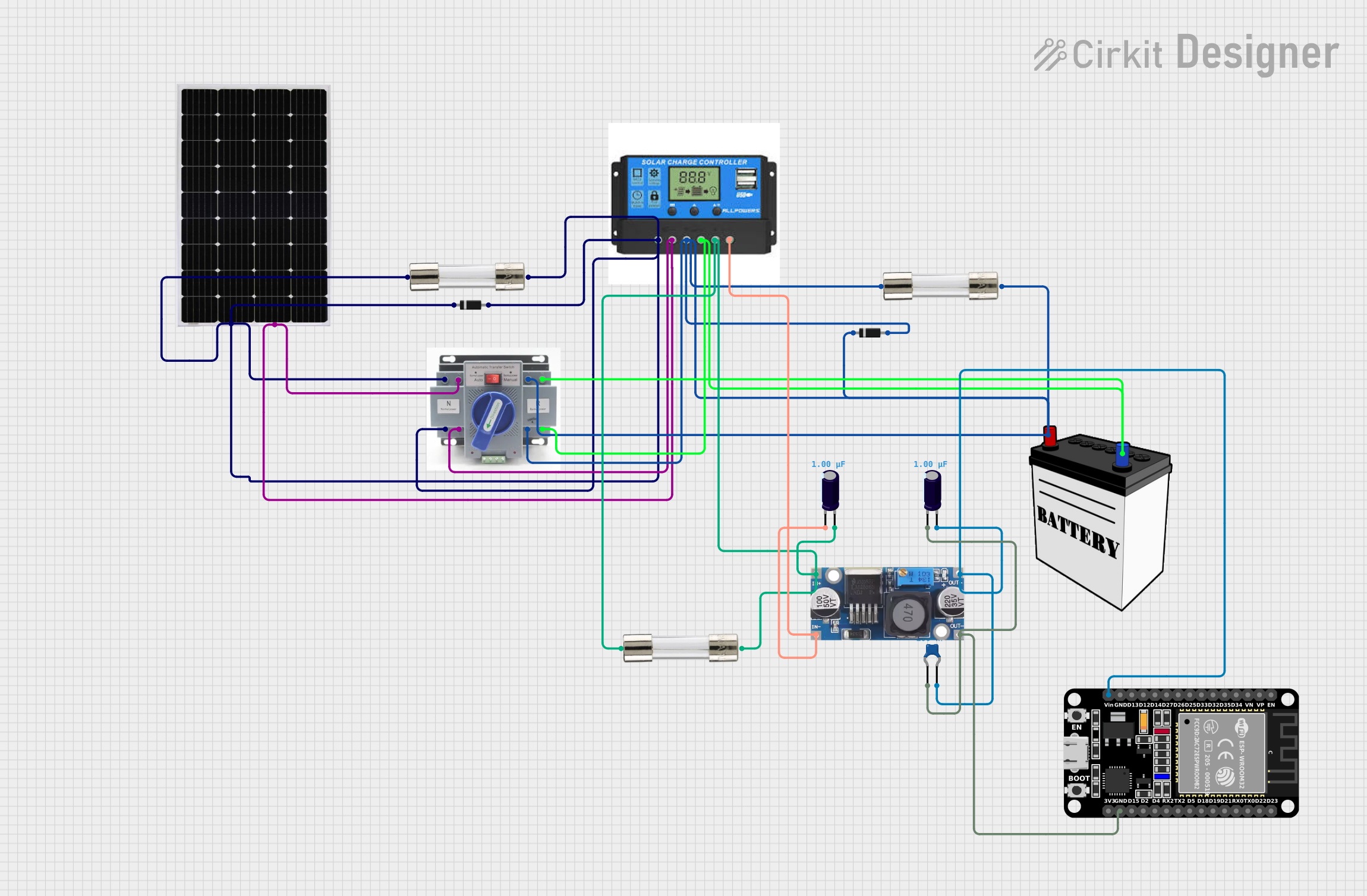
 Open Project in Cirkit Designer
Open Project in Cirkit Designer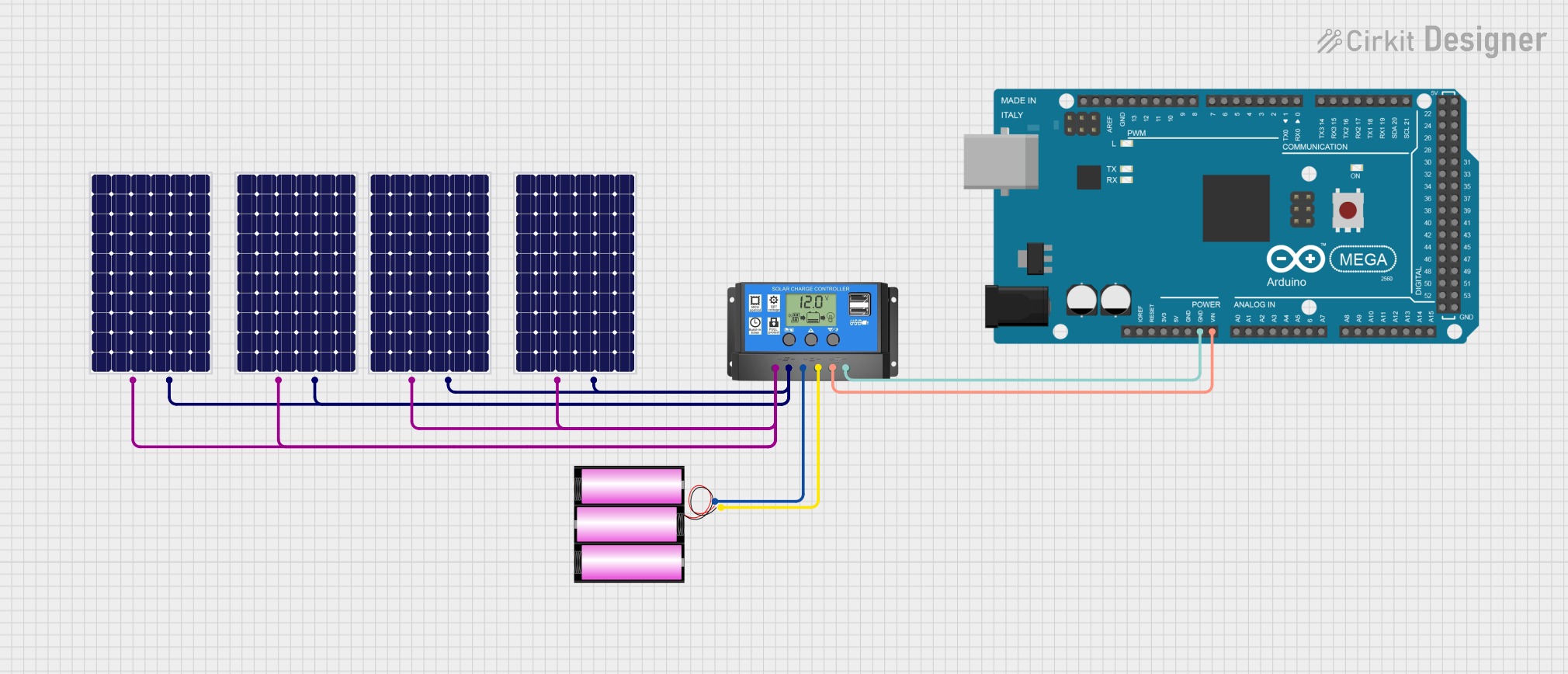
 Open Project in Cirkit Designer
Open Project in Cirkit DesignerExplore Projects Built with Solar charge controller

 Open Project in Cirkit Designer
Open Project in Cirkit Designer
 Open Project in Cirkit Designer
Open Project in Cirkit Designer
 Open Project in Cirkit Designer
Open Project in Cirkit Designer
 Open Project in Cirkit Designer
Open Project in Cirkit DesignerCommon Applications and Use Cases
- Off-grid solar power systems
- Solar-powered lighting systems
- RVs, boats, and caravans
- Remote monitoring and communication systems
- Backup power systems
Technical Specifications
Below are the general technical specifications for a typical solar charge controller. Always refer to the specific datasheet for your model.
Key Technical Details
- Input Voltage Range: 12V/24V auto-detect (common models)
- Maximum Input Current: 10A, 20A, 30A, or higher (depending on the model)
- Battery Voltage: 12V/24V
- Charging Technology: PWM (Pulse Width Modulation) or MPPT (Maximum Power Point Tracking)
- Operating Temperature: -20°C to 60°C
- Efficiency: Up to 98% (for MPPT models)
- Load Control: Overload, short circuit, and reverse polarity protection
Pin Configuration and Descriptions
The solar charge controller typically has the following terminals:
| Pin/Terminal | Label | Description |
|---|---|---|
| 1 | Solar Panel (+) | Positive terminal for connecting the solar panel. |
| 2 | Solar Panel (-) | Negative terminal for connecting the solar panel. |
| 3 | Battery (+) | Positive terminal for connecting the battery. |
| 4 | Battery (-) | Negative terminal for connecting the battery. |
| 5 | Load (+) | Positive terminal for connecting the DC load (e.g., lights, fans). |
| 6 | Load (-) | Negative terminal for connecting the DC load. |
Usage Instructions
How to Use the Solar Charge Controller in a Circuit
- Connect the Battery First: Always connect the battery to the charge controller before connecting the solar panel or load. This ensures the controller detects the correct system voltage (12V or 24V).
- Connect the Solar Panel: Attach the solar panel's positive and negative terminals to the corresponding inputs on the charge controller.
- Connect the Load (Optional): If you want to power a DC load directly, connect it to the load terminals on the charge controller.
- Power On: Once all connections are secure, the charge controller will begin regulating the energy flow automatically.
Important Considerations and Best Practices
- Battery Type: Ensure the charge controller is compatible with your battery type (e.g., lead-acid, lithium-ion).
- System Voltage: Verify that the charge controller supports your system's voltage (12V or 24V).
- Wire Gauge: Use appropriately sized wires to handle the current without overheating.
- Placement: Install the charge controller in a well-ventilated area to prevent overheating.
- Reverse Polarity: Double-check connections to avoid reverse polarity, which can damage the controller.
Arduino Integration Example
While solar charge controllers are standalone devices, you can monitor their performance using an Arduino UNO. Below is an example of how to read battery voltage using an Arduino and a voltage divider circuit.
// Example: Reading battery voltage from a solar charge controller
// Ensure the voltage divider reduces the battery voltage to below 5V for Arduino input.
const int voltagePin = A0; // Analog pin connected to the voltage divider
float voltageDividerRatio = 5.0; // Adjust based on your resistor values
void setup() {
Serial.begin(9600); // Initialize serial communication
}
void loop() {
int sensorValue = analogRead(voltagePin); // Read the analog input
float batteryVoltage = (sensorValue * 5.0 / 1023.0) * voltageDividerRatio;
// Print the battery voltage to the Serial Monitor
Serial.print("Battery Voltage: ");
Serial.print(batteryVoltage);
Serial.println(" V");
delay(1000); // Wait 1 second before the next reading
}
Note: Use a voltage divider circuit to scale down the battery voltage to a safe level for the Arduino's analog input (0-5V).
Troubleshooting and FAQs
Common Issues and Solutions
Controller Not Powering On
- Cause: Battery not connected or low voltage.
- Solution: Ensure the battery is properly connected and charged.
No Charging from Solar Panel
- Cause: Incorrect wiring or insufficient sunlight.
- Solution: Check the solar panel connections and ensure it is exposed to direct sunlight.
Load Not Powering
- Cause: Overload or short circuit protection triggered.
- Solution: Reduce the load or check for short circuits in the wiring.
Overheating
- Cause: Poor ventilation or excessive current.
- Solution: Install the controller in a well-ventilated area and ensure the current is within limits.
FAQs
Q: Can I use the solar charge controller with an inverter?
- A: Yes, connect the inverter directly to the battery terminals, not the load terminals.
Q: How do I know if the battery is fully charged?
- A: Most controllers have an LED or display that indicates the battery's charge status.
Q: Can I connect multiple solar panels to one controller?
- A: Yes, as long as the combined voltage and current do not exceed the controller's ratings.
Q: What is the difference between PWM and MPPT controllers?
- A: MPPT controllers are more efficient and extract maximum power from the solar panel, while PWM controllers are simpler and less expensive.
By following this documentation, you can effectively use a solar charge controller to manage your solar power system.